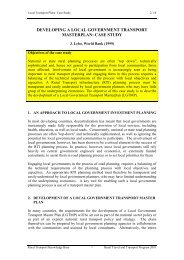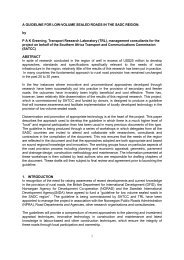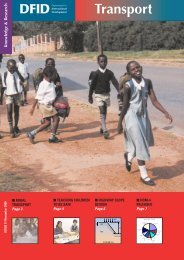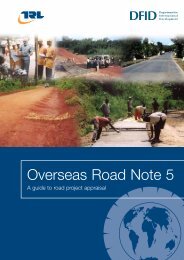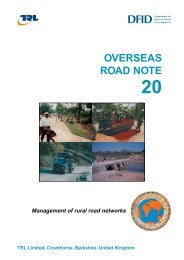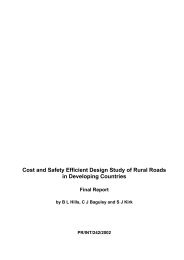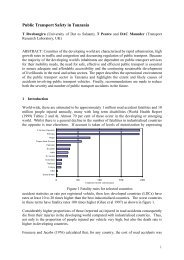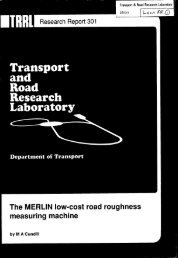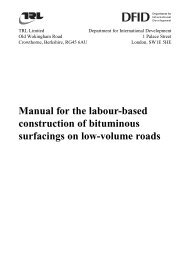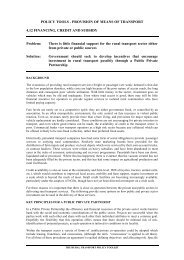Case study: Mkuze River crossing to Phelendaba ... - World Bank
Case study: Mkuze River crossing to Phelendaba ... - World Bank
Case study: Mkuze River crossing to Phelendaba ... - World Bank
Create successful ePaper yourself
Turn your PDF publications into a flip-book with our unique Google optimized e-Paper software.
<strong>Case</strong> Study: <strong>Mkuze</strong> <strong>River</strong> Crossing <strong>to</strong> <strong>Phelendaba</strong>5:4:bENVIRONMENTAL IMPACT ASSESSMENT CASE STUDYMKUZE RIVER CROSSING TO PHELENDABAObjectives of the case <strong>study</strong>R. Millard and S. le Hanie (1999)The EIA used for this case <strong>study</strong> was conducted by Environmental Impact ManagementServices (Pty) Ltd (EIMS) for the South African Roads Agency, Department ofTransport. Permission <strong>to</strong> use the EIA for the case <strong>study</strong> was obtained from RobertMillard, Direc<strong>to</strong>r of EIMS and is gratefully acknowledged.1. INTRODUCTION AND CONTEXTA recent and important development in South Africa has been the introduction ofcompulsory EIA on development proposals through the implementation of Sections 21,22 and 26 of the Environmental Conservation Act (1989) in 1997. The EIA regulationsas they are dubbed, make provision for the assessment of a range of activities from theconstruction or upgrading of facilities for commercial electricity generation and supply <strong>to</strong>the reclamation of land below the high water mark. Included in these activities is theconstruction or upgrading of ‘roads, railways, airfields and associated structures andactivities outside the borders of <strong>to</strong>wn planning schemes’ where ‘roads’ means:• any road declared under section 4(1)(a) of the National Roads Act, 1971 (Act No. 74of 1971), a national road and this includes a part of such road or route; or• a ‘<strong>to</strong>ll road’, by which is meant any road for which a fee is charged for the usethereof; or national freeways; or• a provincial road numbered and administered by a provincial authority and arterialroads and major collec<strong>to</strong>r streets administered by a metropolitan or local authority, or• any road in a designated sensitive area or in any area regarded by the relevantauthority as sensitive.In addition, the Constitution itself upholds the right of individuals <strong>to</strong> an environment thatis not harmful <strong>to</strong> their health or well-being. Finally the recently promulgated NationalEnvironmental Management Act (NEMA) seeks ‘<strong>to</strong> provide for co-operativeenvironmental governance by establishing principles for decision-making on mattersaffecting the environment. It should be clear from the above that the environmentalconsequences of development activities have <strong>to</strong> be taken in<strong>to</strong> account in the decisionmakingprocess.The case <strong>study</strong> that has been chosen is a relatively small EIA that was conducted for aproposed road development in an area of extreme bio-diversity value. Paradoxically thearea is also characterised by high levels of poverty and lack of development. The caseRural Transport Knowledge Base 1 Rural Travel and Transport Program 2001
<strong>Case</strong> Study: <strong>Mkuze</strong> <strong>River</strong> Crossing <strong>to</strong> <strong>Phelendaba</strong>5:4:b<strong>study</strong> has been chosen <strong>to</strong> reflect some key principles of EIA in respect of roadsdevelopment including the following:• How the EIA process should be tailored <strong>to</strong> the decision-making requirements• The types of issues associated with a roads development of this nature• The importance of public participation• The importance of post EIA implementation of recommendations through anEnvironmental Management Programme (EMP).2. THE SOUTH AFRICA EIA REGULATIONSIn essence the South African EIA process consists of three major components namelyScoping, the assessment itself and the finally the decision. Scoping is the processwhereby the full scope of the assessment is determined and involves consultation with abroad group of stakeholders and the general public or so-called ‘interested and affectedparties’ (I&APs). Once the scope of the assessment has been determined the assessmentcan commence <strong>to</strong> address all of the issues that have been identified. These issues areassessed <strong>to</strong> determine whether or not they will result in an impact and the magnitude,duration and resultant significance of that impact. The final stage of the process is thenthe decision which is a collective decision by all the relevant authorities, co-ordinated bythe ‘lead agent’ and indeed by the developers themselves.In terms of the case <strong>study</strong> it is not the intention at all <strong>to</strong> describe the regulations in detailbut rather <strong>to</strong> highlight two important principles. The first of these is the need for publicparticipation, described in the regulations as ensuring ‘public involvement in theundertaking of identified activities’. A second important principle is that the processmakes provision for decision-making on completion of the scoping phase, if theauthorities deem the impacts <strong>to</strong> be well enough unders<strong>to</strong>od at that stage <strong>to</strong> allow for adecision. The significance of this latter component is that the EIA regulations become‘development-friendly’ without compromising in any way on the protection of theenvironment’.3. BACKGROUND TO THE PROPOSED DEVELOPMENTThe portion of the MR439 from the Lower <strong>Mkuze</strong> Crossing <strong>to</strong> <strong>Phelendaba</strong> is the lastsection of the <strong>to</strong>urist access from Hluhluwe <strong>to</strong> the Mozambique border, and ultimately on<strong>to</strong> Mapu<strong>to</strong> that still has a gravel surface. The proposed development was <strong>to</strong> upgrade thisroad and the <strong>crossing</strong> over the adjacent Mozi Swamp in the following manner:• Tar the existing road with minor deviations from its existing alignment• Construct an entirely new <strong>crossing</strong> over the bot<strong>to</strong>m of the Mozi Pan - (1 in 50 yearflood design)• Upgrade the bridge at the lower <strong>Mkuze</strong> Crossing <strong>to</strong> 1 in 50 year flood design• Upgrade the <strong>crossing</strong> over the Mseleni <strong>River</strong> <strong>to</strong> 1in 50 year flood designRural Transport Knowledge Base 2 Rural Travel and Transport Program 2001
<strong>Case</strong> Study: <strong>Mkuze</strong> <strong>River</strong> Crossing <strong>to</strong> <strong>Phelendaba</strong>5:4:b4. CONTEXT4.1 Biophysical environmentMaputaland as the area in which the proposed upgrade would take place has long beenrecognised as an area of considerable biological diversity. It is also an area ofconsiderable environmental controversy following an EIA on a proposal (subsequentlyunsuccessful) <strong>to</strong> extend dune mining operations in the area. Important hydrologicalconsiderations are the many lakes in the area including Lake St Lucia. Vegetation in thearea is complex and interesting, characterised by a high number of endemic species anddescribed as a southern African bio-diversity ‘hot spot’. Included in the area is the MoziSwamp which was once a shallow waterway linking Mapu<strong>to</strong> with St. Lucia. Ilala palmsproliferate and are a primary source of income <strong>to</strong> the local people who produce a palmwine called injemane or ubusulu.Fauna is the area is significant with 112 reptile species of which 20 are consideredinadequately protected and 7 threatened with extinction in the wild. No other area ofSouth Africa possesses the variety of tropical birds for its size with 462 birds having beenrecorded. Of the 101 avifauna species in South Africa that are in need of protection 47occur in Maputaland. Some 102 mammal species have been recorded in the area.4.2 DevelopmentSpatial Development Initiatives (SDI’s) are an important development driver in SouthAfrica and are concerted programmes <strong>to</strong> encourage rapid investment in designated areas.The Lubombo SDI is ‘a strategy <strong>to</strong> convert the mix of human and natural resources of thewider Lubombo terri<strong>to</strong>ry in<strong>to</strong> an internationally competitive zone of economic activityand growth. The MR439 forms a key infrastructural component of the Lubombo SDIwith the following objectives:• Unlock the economic potential of the area• Improve access within north-east Maputaland for local people, <strong>to</strong>urists andcommercial activities• Effect a direct link between northern KwaZulu-Natal and MozambiqueThe area has high eco-<strong>to</strong>urism potential and with peace in Mozambique and thenormalisation of political relations between that country and South Africa, the roadbetween Hluhluwe and Farazela (on the Mozambique border) had become increasinglyutilised by <strong>to</strong>urist traffic. The existing road surface was not adequate <strong>to</strong> cope with theincrease in traffic. The road upgrade was also seen as assisting the improvement of oneof the least developed communities in South Africa.4.3 Social environmentMaputaland is one of the poorest and most underdeveloped areas in southern Africa.Unemployment in the economically active population runs at about 38%, with formalRural Transport Knowledge Base 3 Rural Travel and Transport Program 2001
<strong>Case</strong> Study: <strong>Mkuze</strong> <strong>River</strong> Crossing <strong>to</strong> <strong>Phelendaba</strong>5:4:bemployment being mainly associated with Government services. Most people practisesubsistence agriculture. The economy is not well differentiated with agriculture andforestry accounting for almost 40% of the GDP of the region. The area is richly endowedwith eco<strong>to</strong>urism attractions including game parks, marine reserves, wilderness areas andestuarine environments. Tourism has the potential <strong>to</strong> reverse the slow pace ofdevelopment.5. ENVIRONMENTAL ISSUES5.1 Alternative routingBecause of the eco-<strong>to</strong>urism potential of the Mozi and Yenguenie Pans and the areabetween the pans and the proximity of the existing roadway <strong>to</strong> the Sodwana State Forest,the KwaZulu-Natal Nature Conservation Service (KZNNCS) proposed an alternativerouting for the roadway. They also argued that the alternative routing would providegreater access <strong>to</strong> the Kwa-Jobe Tribal Authority a poor community with extremely lowannual average incomes (R311 pa) and high dependency ratios (15 dependants pereconomically active member). This alternative routing was dubbed the westernalignment.5.2 The Eastern (existing) AlignmentThe major benefit of using the existing alignment was that the bulk of the area <strong>to</strong> beoccupied by the road was already cleared so linear developments and other disturbanceswere already in existence. The existing route was also cheaper because it was shorter.However, negative effects of passing through the state forest are hazards <strong>to</strong> game andgame hazards <strong>to</strong> traffic, opportunistic poaching and noise from the road.5.3 The Western (alternative) AlignmentThe major disadvantages of this route was the need <strong>to</strong> clear some 140 hectares of matureSand Forest. At the same time there was also concern about providing enhanced access<strong>to</strong> woodcutters with a resultant deterioration of the Sand Forest. Some of the benefitsincluded expanding the width of a migration corridor that had been established betweenthe <strong>Mkuze</strong> Game Reserve and the Sodwana State Forest. The western alignment wouldalso have negated the need <strong>to</strong> provide a <strong>crossing</strong> over the Mozi Swamp <strong>to</strong> access Kwa-Jobe.5.4 Upgrading of the <strong>crossing</strong> of the Mozi SwampThe proposed upgrading of the <strong>crossing</strong> would result in several positive impactsincluding removing barriers <strong>to</strong> fish migration, improving access <strong>to</strong> Kwa-Jobe, increasethe frequency of water exchanges, reducing the hypersalinity in LakeSt Lucia andimproved fish yields. Negative impacts included constricting water movement, possibleRural Transport Knowledge Base 4 Rural Travel and Transport Program 2001
<strong>Case</strong> Study: <strong>Mkuze</strong> <strong>River</strong> Crossing <strong>to</strong> <strong>Phelendaba</strong>5:4:bembankment collapse during heavy floods and a reduction in hydrologic pressure on theMkhuze Swamp during floods.6. CONCLUSIONS OF THE EIAThe conclusion drawn was that the eastern (existing) alignment was preferable especiallygiven the vehement opposition expressed by Tribal authorities <strong>to</strong> the western (alternative)alignment. This was not <strong>to</strong> say that the negative impacts identified for the easternalignment would be ignored especially the potential negative impacts of the Mozi Swamp<strong>crossing</strong>. For this reason strict recommendations were included in the EIA as <strong>to</strong> theadoption of a stringent Environmental Management Programme (EMP) that wouldgovern all construction practises.7. CONCLUSIONS IN RESPECT OF THE CASE STUDY1. Highlights the complexity of EIA in terms of the dynamics of social and naturalsystems2. Indicates the importance of public participation <strong>to</strong> take in<strong>to</strong> account both the wants ofthe local people and suggested alternatives3. An extended Scoping <strong>study</strong> proved adequate for decision-making, despite thecomplexity of the issues without invoking an intensive, detailed <strong>study</strong> that wouldhave had significant time and resource implications.4. Provides an indication of the issues that could typically be associated with roadbuilding in a rural and ecologically sensitive setting5. Emphasises the importance of implementing an Environmental ManagementProgramme (EMP) <strong>to</strong> ensure that the recommendations contained in the EIA are putin<strong>to</strong> practise during the execution of the project.Source: Millard R and S le Hanie (1999). <strong>Mkuze</strong> <strong>River</strong> Crossing <strong>to</strong> <strong>Phelendaba</strong>,Environmental Scoping. Report Project SAPR S58-040-01/1. Johannesburg:Environmental Impact Management Services.Rural Transport Knowledge Base 5 Rural Travel and Transport Program 2001



